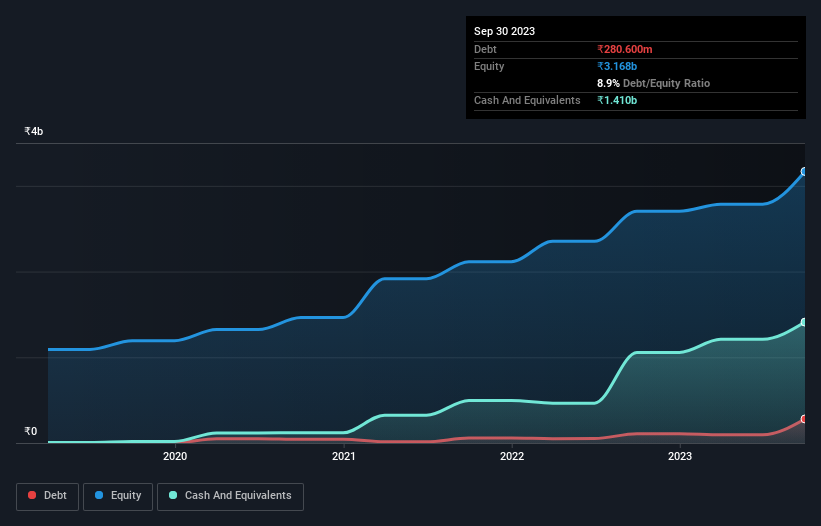Legendary fund manager Li Lu (who Charlie Munger backed) once said, 'The biggest investment risk is not the volatility of prices, but whether you will suffer a permanent loss of capital.' When we think about how risky a company is, we always like to look at its use of debt, since debt overload can lead to ruin. We note that Prakash Pipes Limited (NSE:PPL) does have debt on its balance sheet. But is this debt a concern to shareholders?
Why Does Debt Bring Risk?
Debt assists a business until the business has trouble paying it off, either with new capital or with free cash flow. In the worst case scenario, a company can go bankrupt if it cannot pay its creditors. However, a more usual (but still expensive) situation is where a company must dilute shareholders at a cheap share price simply to get debt under control. Of course, debt can be an important tool in businesses, particularly capital heavy businesses. When we think about a company's use of debt, we first look at cash and debt together.
View our latest analysis for Prakash Pipes
What Is Prakash Pipes's Debt?
You can click the graphic below for the historical numbers, but it shows that as of September 2023 Prakash Pipes had ₹280.6m of debt, an increase on ₹109.0m, over one year. But it also has ₹1.41b in cash to offset that, meaning it has ₹1.13b net cash.

How Strong Is Prakash Pipes' Balance Sheet?
Zooming in on the latest balance sheet data, we can see that Prakash Pipes had liabilities of ₹826.3m due within 12 months and liabilities of ₹45.2m due beyond that. Offsetting this, it had ₹1.41b in cash and ₹796.4m in receivables that were due within 12 months. So it actually has ₹1.34b more liquid assets than total liabilities.
This short term liquidity is a sign that Prakash Pipes could probably pay off its debt with ease, as its balance sheet is far from stretched. Simply put, the fact that Prakash Pipes has more cash than debt is arguably a good indication that it can manage its debt safely.
Fortunately, Prakash Pipes grew its EBIT by 6.7% in the last year, making that debt load look even more manageable. When analysing debt levels, the balance sheet is the obvious place to start. But it is Prakash Pipes's earnings that will influence how the balance sheet holds up in the future. So if you're keen to discover more about its earnings, it might be worth checking out this graph of its long term earnings trend.
Finally, while the tax-man may adore accounting profits, lenders only accept cold hard cash. Prakash Pipes may have net cash on the balance sheet, but it is still interesting to look at how well the business converts its earnings before interest and tax (EBIT) to free cash flow, because that will influence both its need for, and its capacity to manage debt. Looking at the most recent three years, Prakash Pipes recorded free cash flow of 30% of its EBIT, which is weaker than we'd expect. That weak cash conversion makes it more difficult to handle indebtedness.
Summing Up
While it is always sensible to investigate a company's debt, in this case Prakash Pipes has ₹1.13b in net cash and a decent-looking balance sheet. And it also grew its EBIT by 6.7% over the last year. So we don't have any problem with Prakash Pipes's use of debt. When analysing debt levels, the balance sheet is the obvious place to start. However, not all investment risk resides within the balance sheet - far from it. To that end, you should be aware of the 2 warning signs we've spotted with Prakash Pipes .
If you're interested in investing in businesses that can grow profits without the burden of debt, then check out this free list of growing businesses that have net cash on the balance sheet.
New: Manage All Your Stock Portfolios in One Place
We've created the ultimate portfolio companion for stock investors, and it's free.
• Connect an unlimited number of Portfolios and see your total in one currency
• Be alerted to new Warning Signs or Risks via email or mobile
• Track the Fair Value of your stocks
Have feedback on this article? Concerned about the content? Get in touch with us directly. Alternatively, email editorial-team (at) simplywallst.com.
This article by Simply Wall St is general in nature. We provide commentary based on historical data and analyst forecasts only using an unbiased methodology and our articles are not intended to be financial advice. It does not constitute a recommendation to buy or sell any stock, and does not take account of your objectives, or your financial situation. We aim to bring you long-term focused analysis driven by fundamental data. Note that our analysis may not factor in the latest price-sensitive company announcements or qualitative material. Simply Wall St has no position in any stocks mentioned.
About NSEI:PPL
Prakash Pipes
Manufactures and sells PVC pipes, fittings, and flexible packaging solutions in India and internationally.
Excellent balance sheet second-rate dividend payer.
Market Insights
Community Narratives




